12 Best Lead Generation Software Tools for 2025
In 2025, a steady stream of qualified leads is the lifeblood of any growing business. But the market is crowded with tools, from all-in-one CRMs to specialized prospecting platforms. Choosing the wrong one wastes time and money; the right one becomes your growth engine. This guide cuts through the noise to provide an in-depth analysis of the 12 best lead generation software solutions, focusing on real-world use cases, honest limitations, and actionable insights.
Whether you're a SaaS startup building high-converting landing pages, a B2B sales team running outbound campaigns, or a marketer capturing on-site traffic, this breakdown will help you identify the platform that aligns perfectly with your specific goals and budget. We've moved beyond generic feature lists to give you a comprehensive resource with detailed reviews, feature comparisons, and clear pricing information for each tool.
Our goal is to help you make a confident, informed decision. To truly maximize the potential of these platforms, it's essential to pair powerful software with a strong strategy. Understanding fundamental Sales Prospecting Best Practices will ensure your team can convert the data you gather into tangible pipeline growth.
This list covers a range of solutions, from B2B data providers like ZoomInfo and Apollo.io to on-site conversion tools like OptinMonster and landing page builders like Leadpages. Each review includes screenshots and direct links, allowing you to quickly evaluate the software that fits your needs and skip the ones that don't. Let's find your growth engine.
1. Pages.Report
Pages.Report operates as a powerful research-to-action platform, uniquely positioning itself as one of the best lead generation software solutions for teams focused on conversion rate optimization. Instead of abstract marketing theory, it provides a searchable, meticulously curated library of what top-performing SaaS landing pages are actually doing to succeed. This insight-driven approach helps marketing, design, and product teams reverse-engineer proven strategies to enhance their own lead generation funnels.
The platform compresses the lessons from hundreds of successful SaaS companies into repeatable patterns and actionable assets. For SaaS startups and scale-ups, this means bypassing common mistakes and accelerating the iteration cycle for conversion-focused copy and design.
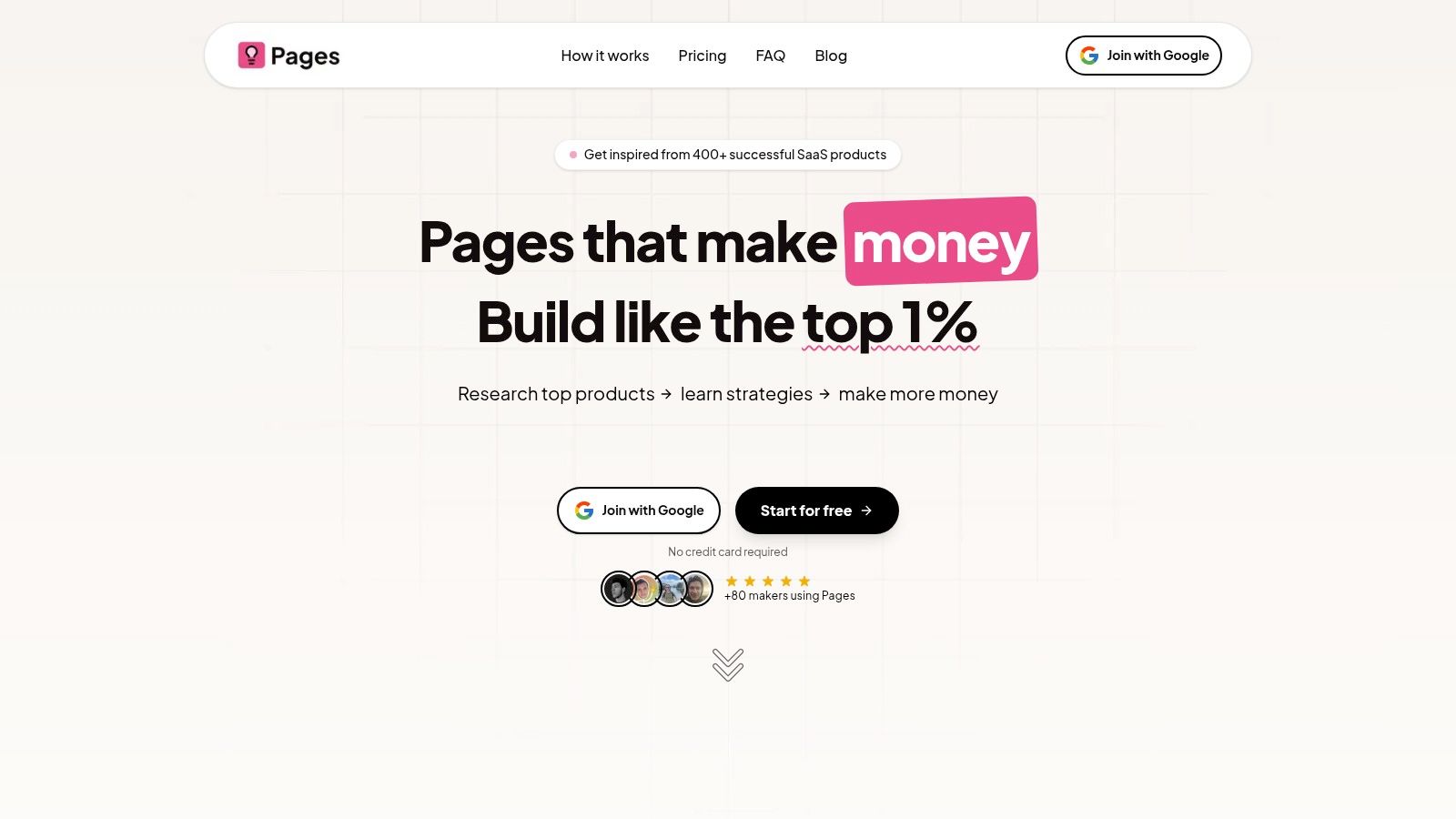
Key Features & Analysis
Pages.Report's core strength lies in its ability to translate research directly into implementation-ready assets. The platform meticulously deconstructs high-performing landing pages, providing detailed reports on UI/UX patterns, value proposition framing, copywriting techniques, and underlying SEO strategies.
- Actionable Assets: Users get immediate access to Figma-ready designs, headline swap suggestions, and code-ready exports for Framer and Webflow, with React components planned. This dramatically reduces the friction between identifying an improvement and deploying it live.
- Curated SaaS Database: The library contains over 370 real-world examples from successful SaaS companies across more than 110 categories. This allows for hyper-targeted competitor analysis and pattern discovery relevant to specific niches.
- Continuous Updates: The database is not static. With over 50 new reports and analyses added weekly, the content remains fresh, relevant, and aligned with current market trends.
- Expert Guidance: The Pro package includes a free, hands-on landing page audit (subject to availability), offering personalized feedback to help teams apply the platform's insights directly to their own assets.
Use Cases and Implementation
The platform is ideal for product managers seeking data-backed design validation, marketers refining campaign landing pages, or founders aiming to establish a strong initial conversion framework. For example, a marketing team struggling with a high bounce rate can filter the database for "B2B SaaS" and "AI" to study how leaders in their space structure hero sections and present social proof, then use the provided Figma assets to quickly prototype a new layout.
Pricing and Access
Pages.Report offers a flexible entry point. Users can start with a free plan without requiring a credit card to explore the basic offering. For full access, the platform currently promotes a limited-time lifetime access deal priced at $29, which includes all current and future analyses, ongoing updates, and additional assets.
Website: https://pages.report
| Feature | Details |
|---|---|
| Best For | SaaS startups, marketers, product managers, and designers focused on landing page conversion optimization |
| Key Differentiator | Turns competitive research into ready-to-use Figma files, code exports, and copy suggestions |
| Pricing | Free plan available; limited-time lifetime deal offered at $29 |
| Pros | Highly actionable, extensive and curated SaaS-specific database, continuous updates, hands-on audit |
| Cons | Niche focus on SaaS may limit utility for other industries; premium perks like audits are limited |
2. HubSpot
HubSpot Marketing Hub is an all-encompassing platform designed for businesses that want a single, unified system for capturing, nurturing, and managing leads. Its primary strength lies in connecting every stage of the customer journey, from the first touchpoint on a landing page to the final conversion within its native CRM. This integrated approach eliminates the data silos and integration headaches common with using multiple disparate tools, making it one of the best lead generation software options for scaling teams.
The platform provides a complete suite of lead capture tools, including intuitive builders for landing pages, forms, pop-ups, and live chat. What sets it apart is how these tools seamlessly feed leads directly into the HubSpot CRM, where they can be segmented, scored, and entered into automated nurturing workflows using email marketing and ad retargeting.
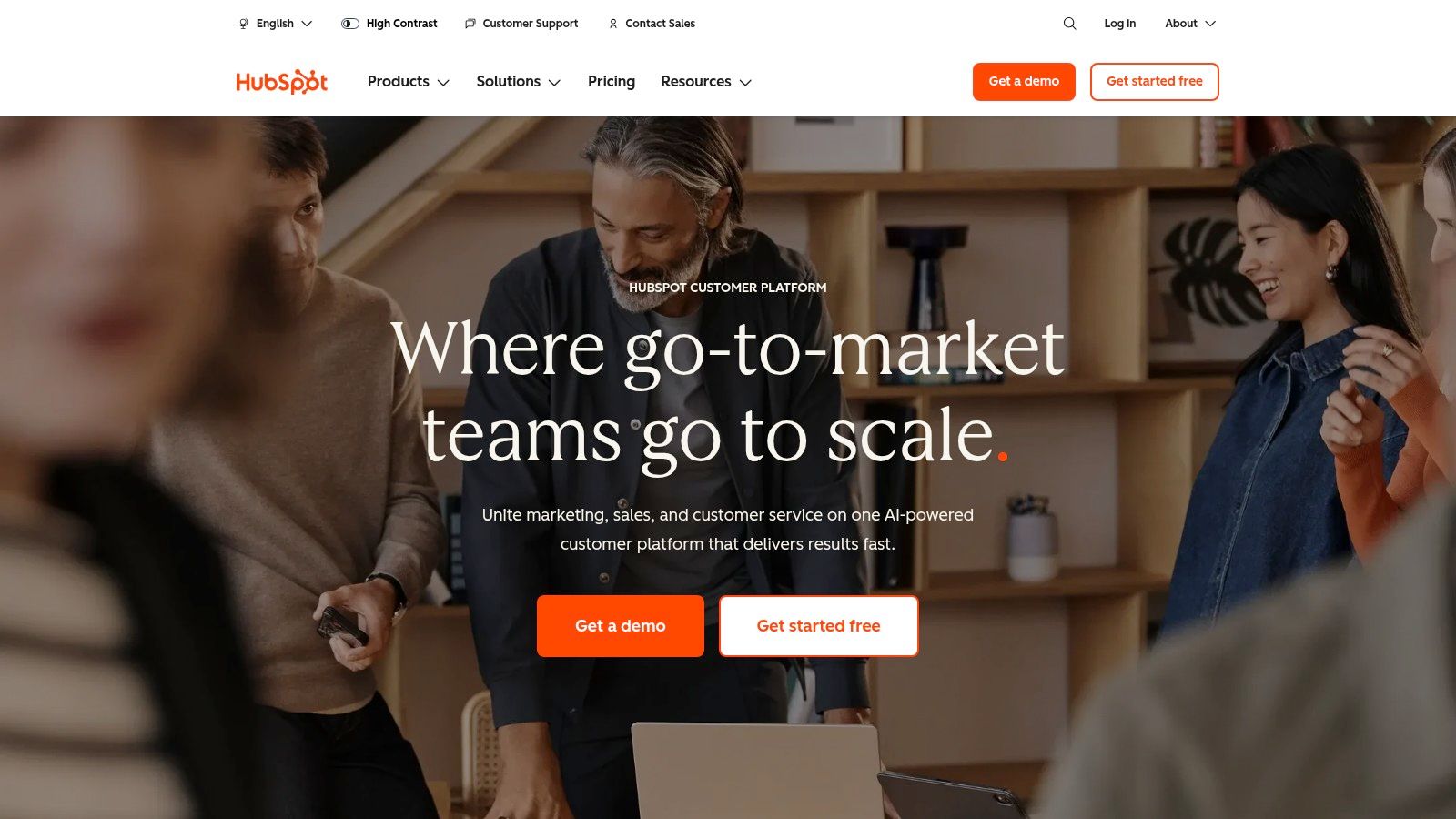
Key Features and Use Cases
- End-to-End Lead Management: A small SaaS company can use HubSpot to create an ebook landing page, capture leads with a form, and automatically enroll them in an email drip campaign to guide them toward a demo request.
- Native CRM Integration: All lead activity and data are stored in one place, providing sales and marketing teams with a unified view of every contact's history. This is a critical feature for aligning sales and marketing efforts.
- AI-Powered Insights: HubSpot's AI features (formerly Breeze) can automatically enrich contact data, predict buyer intent, and even help shorten forms to reduce friction, although these capabilities may consume credits depending on your plan. For more insights on how startups can leverage such platforms, explore these essential marketing tools for startups.
- Extensive App Marketplace: Integrates with hundreds of other tools, from Slack to Salesforce, ensuring it fits within your existing tech stack.
Pricing and Limitations
HubSpot offers a free tier with basic tools, but its powerful automation and AI features are reserved for paid plans (Starter, Professional, and Enterprise), which can become a significant investment. The platform's all-in-one nature can also feel overwhelming for teams only needing a simple lead capture tool.
Website: https://www.hubspot.com
3. LinkedIn Sales Navigator
LinkedIn Sales Navigator is a specialized B2B prospecting tool built directly on LinkedIn’s professional network. It is designed for sales teams that need to identify, research, and connect with high-value leads and accounts. Its core strength lies in leveraging the unparalleled dataset of LinkedIn profiles, offering advanced search filters and real-time alerts that go far beyond the platform's standard capabilities. This makes it an indispensable tool for targeted B2B lead generation where account-based marketing and precise professional targeting are critical.
The platform provides an enhanced interface separate from the main LinkedIn experience, focused entirely on prospecting. Users can build and save hyper-specific lead lists based on criteria like company size, seniority level, and recent job changes. What truly sets it apart is the ability to receive real-time updates on key accounts and saved leads, such as when they share content or are mentioned in the news, providing timely opportunities for outreach.
Key Features and Use Cases
- Advanced B2B Prospecting: A sales development representative can use the 50+ advanced filters to build a list of VPs of Engineering at Series B tech companies in North America who have changed jobs in the last 90 days.
- Real-time Account and Lead Alerts: Stay informed about key personnel changes, company growth signals, and content shares from target accounts, creating warm conversation starters for outreach. For those looking to maximize their outreach on the platform, learn how to use LinkedIn Sales Navigator like a growth hacker.
- AI-Powered Summaries (In Beta/Rolling Out): Features like Account IQ and Lead IQ use AI to generate summaries and key insights on accounts and prospects, speeding up research time. This is particularly useful when preparing for discovery calls and requires a deep understanding of your target buyer personas.
- CRM Integration: Higher tiers (Advanced Plus) offer CRM write-back, allowing teams to sync lead and account data directly into Salesforce and other platforms to maintain a single source of truth.
Pricing and Limitations
LinkedIn Sales Navigator pricing is not publicly listed and requires contacting their sales team, with multiple tiers (Core, Advanced, and Advanced Plus) offering different feature sets. While its data is unmatched for B2B professionals, the platform operates as a closed ecosystem. The cost can be a significant investment, and its most powerful features, like deep CRM integration, are limited to the highest-priced plans.
Website: https://business.linkedin.com/sales-solutions/sales-navigator
4. ZoomInfo (SalesOS)
ZoomInfo SalesOS is an enterprise-grade B2B intelligence platform built for sales and marketing teams that need access to a vast, actionable database of contacts and company information. Its core value lies in providing deep data insights, including direct dials, email addresses, technographics, and buyer intent signals, which empower outbound sales motions. This focus on providing high-quality, targeted data makes it one of the best lead generation software choices for organizations prioritizing sales-led growth and account-based marketing.
The platform goes beyond just being a database by integrating sales engagement tools directly into its system. Users can build targeted prospect lists based on incredibly specific criteria, enrich their existing CRM data, and reach out using a built-in sales dialer and engagement workflows, creating a streamlined process from prospecting to outreach.
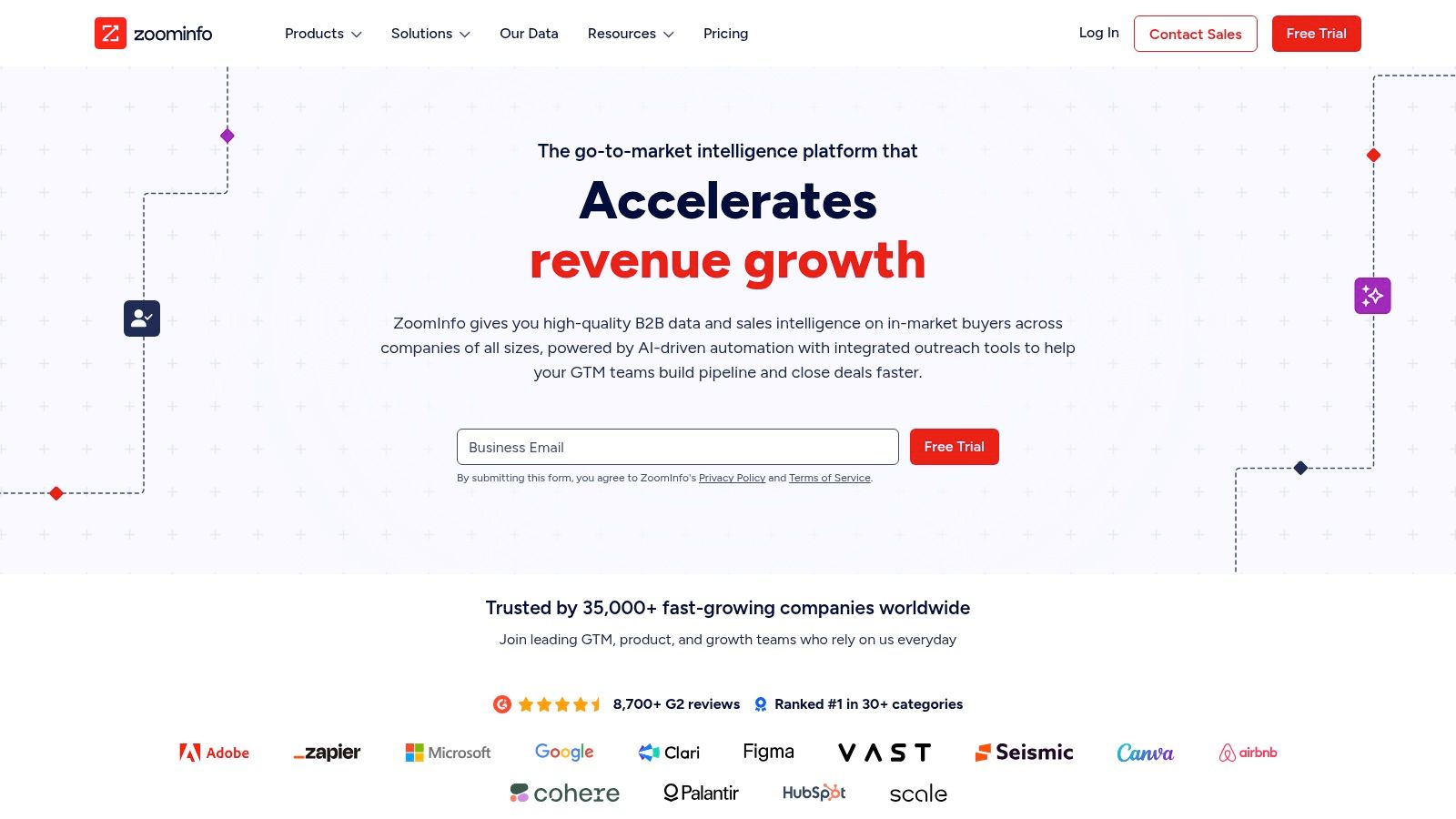
Key Features and Use Cases
- Targeted Outbound Prospecting: An enterprise software company can identify companies using a competitor's technology, filter for decision-makers in a specific department, and uncover their direct contact information to launch a highly targeted sales campaign.
- Buyer-Intent Data: ZoomInfo can signal when a target account is actively researching solutions like yours, allowing sales teams to prioritize outreach to prospects who are already in-market and showing strong purchase intent.
- Data Enrichment and Cleansing: The platform integrates directly with major CRMs like Salesforce and HubSpot to automatically clean, update, and enrich existing contact and account records, ensuring data hygiene and accuracy.
- Integrated Sales Tools: Its suite includes a dialer, email automation, and conversation intelligence, allowing sales reps to execute their outreach strategies without leaving the platform.
Pricing and Limitations
ZoomInfo’s pricing is quote-based and tailored to enterprise needs, often involving significant annual contracts that can be prohibitive for smaller businesses. While its database is extensive, some user feedback points to occasional inaccuracies in contact data and a sales process that can feel aggressive.
Website: https://www.zoominfo.com
5. Apollo.io
Apollo.io is a powerful all-in-one sales intelligence and engagement platform that combines a massive B2B contact database with tools for prospecting, outreach, and analytics. Its core strength is unifying lead data discovery with the tools needed to act on that data, such as email sequencing and a built-in dialer. This integrated approach makes it an excellent choice for sales and marketing teams looking to streamline their outbound lead generation efforts without juggling multiple subscriptions.
The platform allows users to build highly targeted lead lists using dozens of specific filters, from company size and technology used to hiring signals and funding rounds. Once a list is built, leads can be directly enrolled into automated multi-step outreach campaigns. This seamless transition from prospecting to engagement in one interface is what positions Apollo.io as one of the best lead generation software options for outbound-focused teams.
Key Features and Use Cases
- Targeted B2B Prospecting: A B2B SaaS startup can use Apollo to find every Head of Marketing at US-based companies with 50-200 employees that use HubSpot, then push them directly into a personalized email sequence.
- Integrated Sales Engagement: The platform's native dialer and sequencing tools allow sales development representatives (SDRs) to manage their entire outreach workflow without leaving the app, increasing efficiency.
- Data Enrichment and Intent Signals: Apollo can enrich existing CRM records with fresh data and provides buying intent signals to help teams prioritize accounts that are actively researching solutions.
- Robust Integrations: It connects seamlessly with popular CRMs like Salesforce and HubSpot, ensuring lead data and activities are synced across the sales stack.
Pricing and Limitations
Apollo.io offers a generous free plan that includes email credits, making it accessible for testing. Paid plans (Basic, Professional, and Custom) unlock higher credit limits, advanced features, and more integrations. A potential limitation is that data accuracy can vary, and some contact information may be outdated. The credit system for exports and email verification also requires careful management to stay within plan limits.
Website: https://www.apollo.io
6. Lusha
Lusha is a B2B contact data provider designed for sales and marketing teams that need quick, accurate contact information. Its core strength is its browser extension, which allows users to find direct emails and phone numbers for prospects directly from LinkedIn profiles, company websites, and even within CRMs like Salesforce. This on-the-fly prospecting capability makes it an invaluable tool for sales development representatives (SDRs) looking to enrich leads in real-time without disrupting their workflow.
The platform operates on a credits-based system, where users spend credits to reveal contact details. This model provides flexibility but requires careful management to stay within budget. By streamlining the often tedious process of manual data gathering, Lusha helps teams build highly targeted outreach lists with verified data, positioning it as one of the best lead generation software options for direct prospecting and sales intelligence.
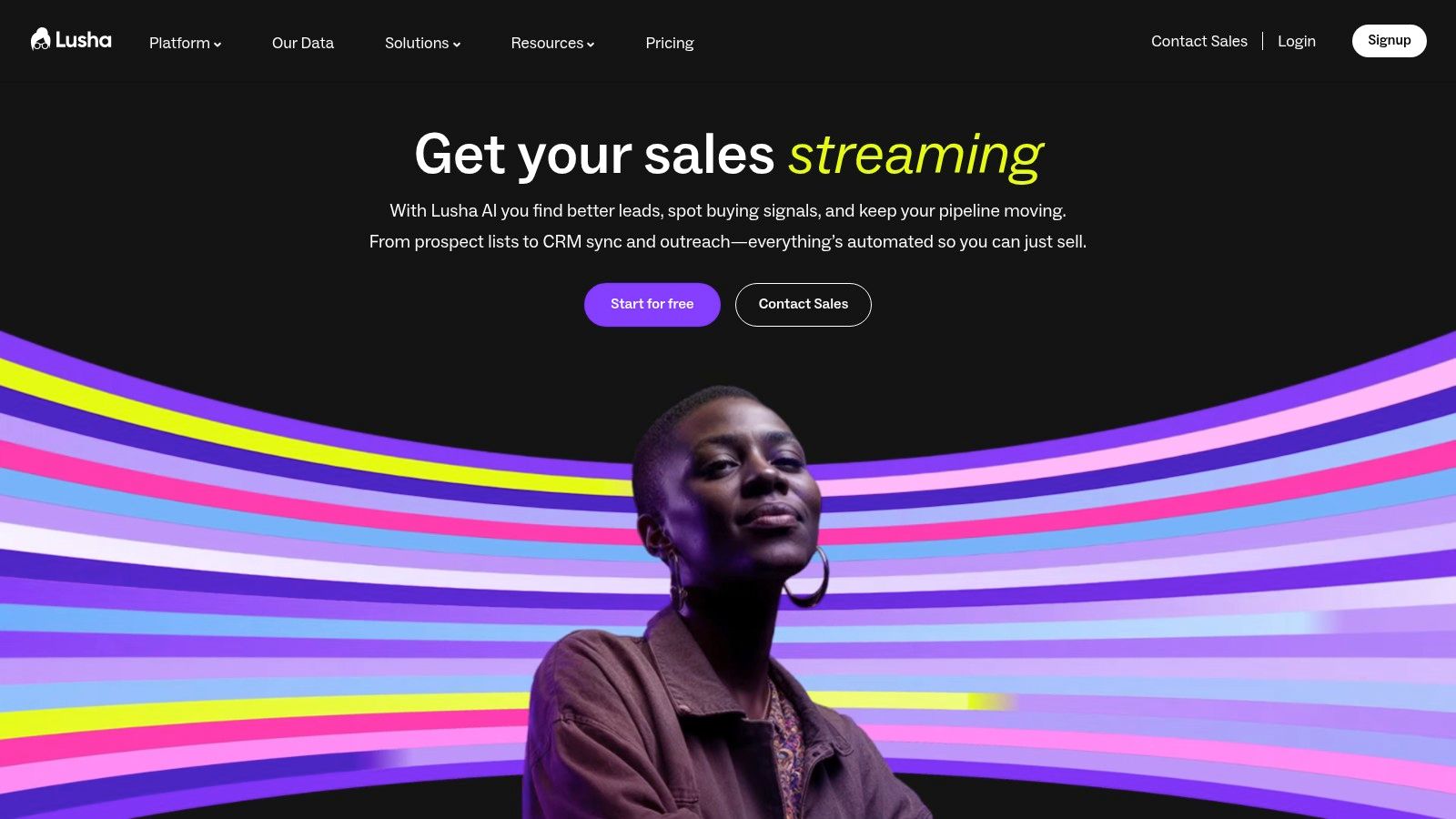
Key Features and Use Cases
- On-the-Fly Prospecting: An SDR researching a target account on LinkedIn can use the Lusha Chrome extension to instantly pull the decision-maker's direct dial number and verified email address, adding them directly to a CRM or sales engagement platform.
- Direct CRM Integration: Lusha integrates with major platforms like Salesforce, HubSpot, and SalesLoft, allowing users to enrich existing contact records or add new prospects with verified data in a single click, ensuring data hygiene.
- API for Bulk Enrichment: For teams needing to enrich large databases, Lusha's API can programmatically update contact lists with the latest phone numbers and emails, saving countless hours of manual work.
- Company Data Access: Beyond individual contacts, users can access detailed firmographic data, including company size, revenue, and technology stacks, to better qualify and segment target accounts.
Pricing and Limitations
Lusha offers a free plan with a limited number of monthly credits, making it easy to test its accuracy and workflow. Paid plans (Pro, Premium, and Scale) offer more credits, advanced features like list exporting, and API access. The primary limitation is the credit system itself; phone number reveals cost more than emails, and API usage consumes credits, which can be depleted quickly without careful planning and team-wide usage policies.
Website: https://www.lusha.com
7. Hunter
Hunter is a highly specialized tool focused on one critical aspect of lead generation: finding and verifying professional email addresses. It excels at helping sales and marketing teams build targeted B2B contact lists from scratch. Its strength lies in its simplicity, accuracy, and transparent, credit-based system, making it an indispensable tool for outbound prospecting and cold email outreach campaigns where data quality is paramount.
The platform allows users to find email addresses associated with a specific domain, search for an individual's email using their name and company, or perform bulk lookups. Each search is backed by a verification process that checks email deliverability, reducing bounce rates and protecting sender reputation. This focus on ethical and accurate data sourcing makes it a top-tier choice among the best lead generation software for teams that prioritize precision over sheer volume.
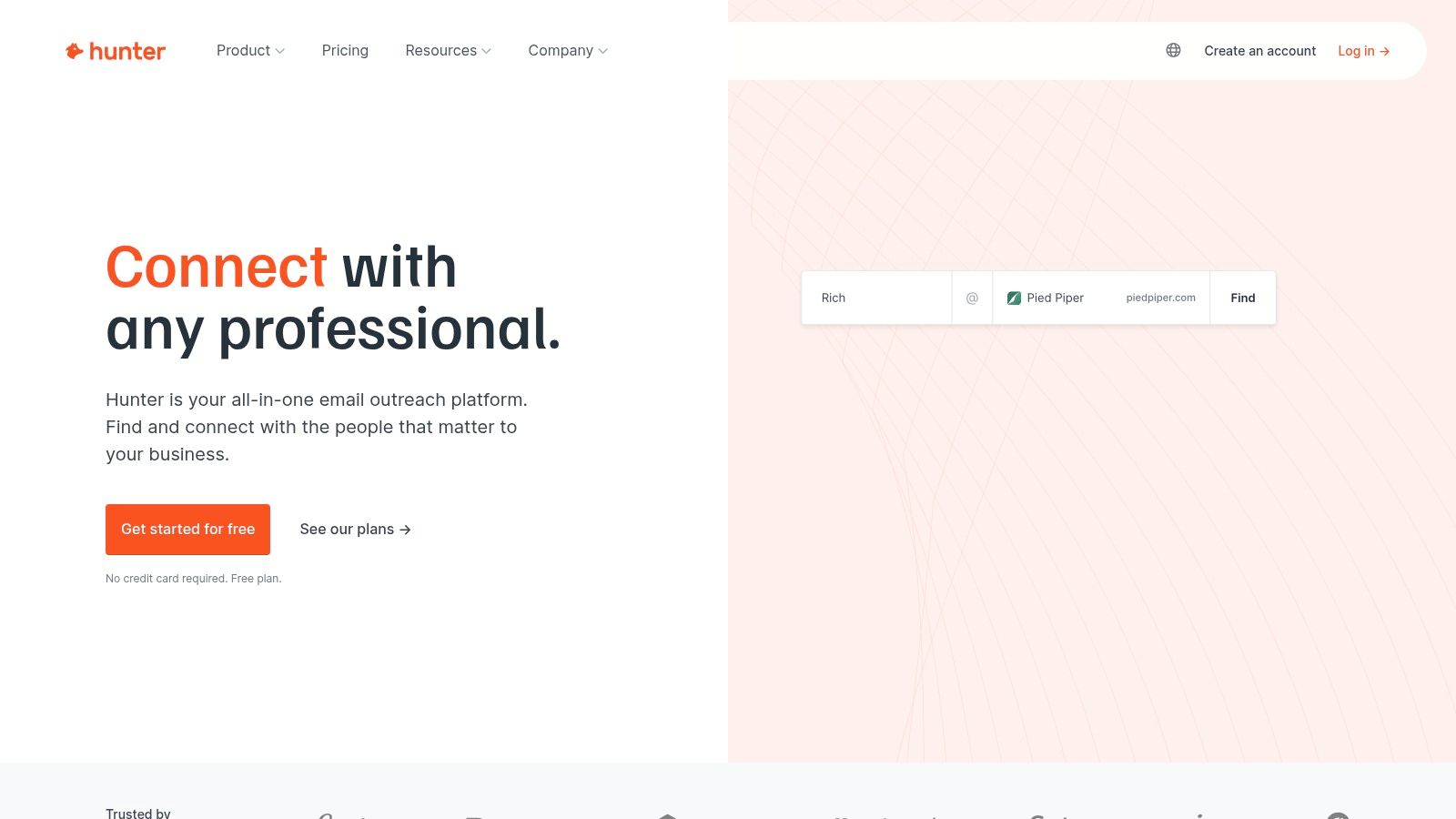
Key Features and Use Cases
- Targeted B2B List Building: A sales development representative can use the Domain Search feature to quickly identify key contacts at a target company and verify their email addresses before adding them to an outreach sequence.
- Email Verification: Before launching a major email marketing campaign, a team can use the Bulk Email Verifier to clean its existing list, ensuring maximum deliverability and engagement.
- Simple Outreach Campaigns: Hunter's "Campaigns" feature allows for basic cold email sequences with tracking, making it a lightweight alternative to more complex sales engagement platforms. The Google Sheets add-on is particularly useful for managing prospects directly from a spreadsheet.
- Browser Extension: The Chrome extension enables users to find email addresses associated with the website they are currently visiting, streamlining the prospecting workflow.
Pricing and Limitations
Hunter offers a free plan with a limited number of monthly searches and verifications. Paid plans are based on a credit system, providing flexibility but requiring careful management to avoid running out. Its primary limitation is its narrow focus on email; it does not provide phone numbers, company firmographics, or buyer intent data, making it a supplementary tool rather than an all-in-one platform.
Website: https://hunter.io
8. Leadpages
Leadpages is a specialized conversion toolkit focused on one primary goal: helping businesses create high-converting landing pages and lead capture assets without needing a developer. Its core strength is its simplicity and speed, offering a drag-and-drop builder and a vast library of professionally designed templates that are optimized for conversions. This makes it an ideal solution for marketers and small businesses who need to launch campaigns quickly and efficiently.
Unlike all-in-one platforms, Leadpages hones in on the top-of-funnel capture process. It provides tools to build not just landing pages but also pop-ups, alert bars, and even complete websites. Its clear focus on conversion design principles helps users build assets that are not only visually appealing but also structured to drive action, cementing its place as one of the best lead generation software options for rapid campaign deployment.

Key Features and Use Cases
- Rapid Campaign Launch: A digital marketing agency can use Leadpages to quickly create a dedicated landing page for a client's new webinar, integrating it with the client’s email marketing tool to collect registrations in under an hour.
- A/B Testing and Optimization: The platform's built-in A/B testing allows users to experiment with different headlines, images, and calls-to-action to maximize conversion rates. You can find more tips on building a high-converting landing page to complement these tests.
- On-Site Lead Capture: Includes pop-ups and alert bars that can be triggered by exit intent, time on page, or link clicks to capture leads from existing website traffic.
- Built-in Payments: Users can connect a Stripe account to accept payments directly on a landing page, making it useful for selling digital products, consultations, or event tickets.
Pricing and Limitations
Leadpages offers a 14-day free trial, with paid plans starting at a competitive price point. However, it is not a full CRM or marketing automation platform. To nurture leads effectively, you must integrate it with a separate email marketing service or CRM. Additionally, the number of custom domains and users can be limited on lower-tier plans, which may increase the total cost for growing teams.
Website: https://www.leadpages.com
9. OptinMonster
OptinMonster is a powerful on-site conversion optimization toolkit focused on converting website traffic into leads, subscribers, and customers. Its core strength lies in its advanced targeting rules and behavioral triggers, allowing businesses to display highly relevant offers to visitors at the precise moment they are most likely to convert. This makes it an essential piece of lead generation software for ecommerce stores, publishers, and agencies looking to maximize their existing traffic without overhauling their entire website.
The platform excels at creating dynamic and engaging campaigns like pop-ups, floating bars, and gamified wheels using an intuitive drag-and-drop builder. What truly sets OptinMonster apart is its renowned Exit-Intent® technology, which detects when a user is about to leave the site and presents a targeted campaign to recapture their attention. This single feature is a game-changer for reducing cart abandonment and growing email lists.
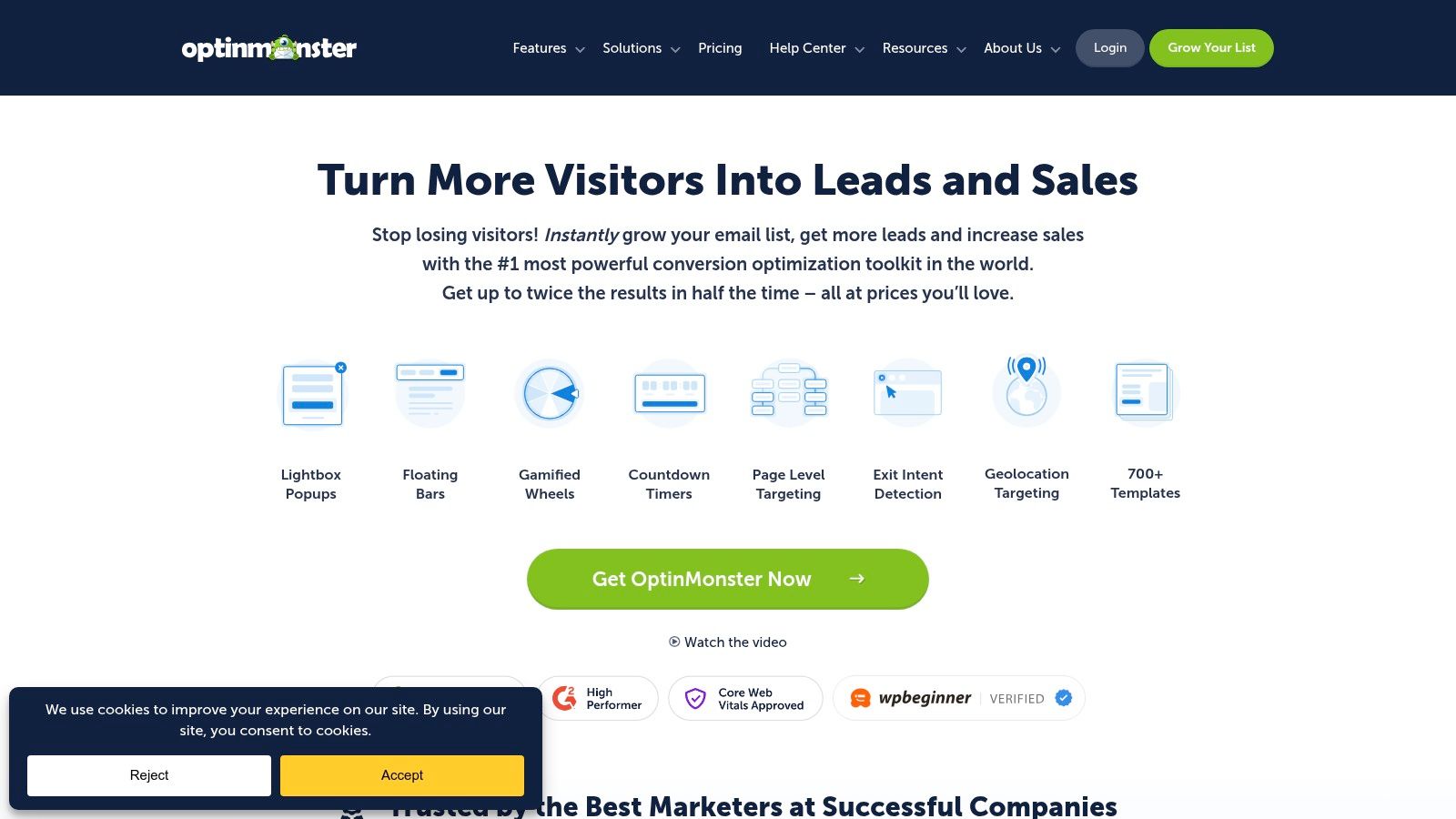
Key Features and Use Cases
- Exit-Intent® Pop-ups and Behavior Triggers: An ecommerce store can use an exit-intent pop-up to offer a 10% discount coupon to visitors who are about to abandon their shopping cart, directly recovering potentially lost revenue.
- Advanced Campaign Targeting: A B2B service provider can use geotargeting to show a case study relevant to a visitor's specific city or use page-level targeting to display a relevant ebook download offer only on blog posts related to that topic.
- A/B Testing and Analytics: Marketers can easily test different headlines, images, and calls-to-action to see which campaign converts best, using data to continuously optimize lead capture performance.
- Broad Platform Integration: Seamlessly connects with all major email marketing services like Mailchimp and Constant Contact, as well as e-commerce platforms like Shopify and WooCommerce.
Pricing and Limitations
OptinMonster offers tiered pricing (Basic, Plus, Pro, and Growth) with no free plan, though it does have a 14-day money-back guarantee. A significant limitation is that each plan comes with a pageview cap, meaning fast-growing sites may need to upgrade their plan sooner than expected. While powerful, achieving the best results requires a commitment to testing and refining campaign designs and triggers.
Website: https://optinmonster.com
10. Seamless.AI
Seamless.AI is a real-time B2B search engine designed for sales and marketing teams needing fast access to verified contact information. Its core function is to find direct dials and email addresses for professionals, positioning itself as a powerful tool for outbound prospecting and list building. Unlike static databases, Seamless.AI uses an AI-driven engine to find and verify data in the moment, reducing the risk of hitting outdated contacts.
The platform excels at empowering sales development representatives (SDRs) to build highly targeted lists without leaving their workflow, thanks to its browser extension that works directly on LinkedIn and company websites. This integration, combined with its flexible credit system and add-on features like buyer intent data and job change alerts, makes it a strong contender for teams focused on high-volume, precision-targeted outreach.
Key Features and Use Cases
- Real-Time Contact Discovery: An SDR prospecting on LinkedIn can use the Seamless.AI extension to instantly find the email address and direct phone number of a decision-maker, adding them directly to a Salesforce or HubSpot campaign in one click.
- Flexible Add-On Modules: A marketing team can start with basic contact discovery and later add the "Buyer Intent" data module to identify companies actively researching their solutions, allowing them to prioritize outreach efforts effectively.
- Direct CRM and CSV Integration: The ability to export clean, enriched data via CSV or push it directly into major CRMs streamlines list-building and eliminates manual data entry.
- Daily Credit Refresh: On paid plans, credits often refresh daily, encouraging consistent prospecting habits rather than forcing teams to ration a monthly allowance.
Pricing and Limitations
Seamless.AI offers a free plan with a limited number of credits, which is excellent for validating its data quality for your specific industry. Paid plans offer more credits and features, but exact pricing for higher tiers often requires a sales quote. The data quality can vary by niche, so it's crucial to utilize the free trial to test its accuracy against your ideal customer profile before committing to a larger plan.
Website: https://www.seamless.ai
11. Salesforce AppExchange
Salesforce AppExchange isn't a single piece of software but rather Salesforce's official marketplace, offering thousands of vetted third-party applications. For organizations already embedded in the Salesforce ecosystem, it serves as a powerful extension for lead generation, providing specialized tools for lead capture, routing, matching, and data enrichment. Its primary value is offering click-to-install solutions that seamlessly integrate into an existing Salesforce org, eliminating complex setup and compatibility issues.
The platform allows businesses to find, trial, and install apps that address specific gaps in their lead management process. Instead of a one-size-fits-all approach, a company can select a best-in-class tool for a specific function, like advanced form building or automated lead-to-account matching, knowing it has been reviewed for security and quality by Salesforce. This makes it one of the best lead generation software hubs for enhancing a Salesforce-centric strategy.
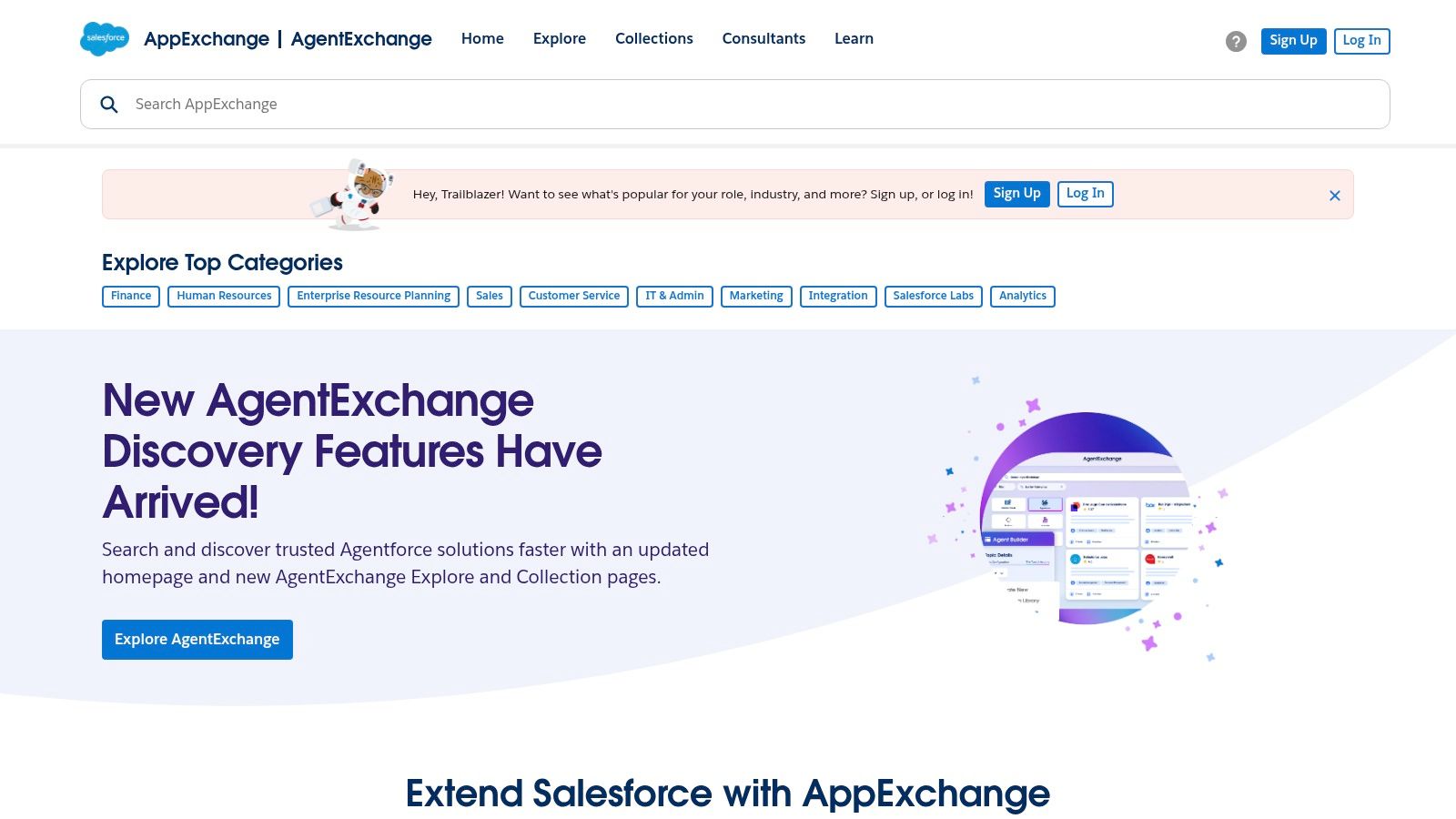
Key Features and Use Cases
- Targeted Lead Generation Solutions: A B2B enterprise can install an app like Chili Piper for intelligent lead routing or ZoomInfo for real-time contact data enrichment directly within their sales team's existing Salesforce workflow.
- Click-to-Install Simplicity: The primary benefit is ease of implementation. Apps are installed directly into your Salesforce org, often with minimal configuration, drastically reducing deployment time compared to standalone tools.
- Vetted and Reviewed Ecosystem: All apps undergo a rigorous Salesforce security review, providing trust and reliability. User reviews, detailed listings, and transparent release dates help teams make informed procurement decisions.
- Free Trials and Transparent Pricing: Many applications offer free trials or freemium versions, allowing teams to test functionality before committing. Pricing models, often per-user, are clearly stated on the listing.
Pricing and Limitations
Pricing varies dramatically by app, with models ranging from free to thousands of dollars per month based on user count or usage. The AppExchange's biggest limitation is its dependency: you must have a Salesforce org to use any of the applications. Additionally, the value of many apps is tied to the scale of your Salesforce footprint, as per-user costs can add up quickly.
Website: https://appexchange.salesforce.com
12. G2 (Lead Generation category)
While not a lead generation tool itself, G2’s dedicated category is an indispensable resource for discovering and vetting the best lead generation software on the market. It acts as a peer-review and comparison hub where B2B professionals can research, compare, and shortlist tools based on thousands of verified user reviews. This meta-level approach provides an unbiased, crowd-sourced perspective that marketing copy from individual vendors simply cannot offer.
G2 excels at helping teams navigate a crowded software landscape. Its dynamic Grid reports and comparison matrices allow you to filter tools by company size, user satisfaction, market presence, and specific features. This allows a user to quickly see how leaders like ZoomInfo stack up against challengers like Apollo.io based on real-world feedback, moving beyond marketing claims to make a data-driven decision.
Key Features and Use Cases
- Vendor Shortlisting: A marketing manager tasked with finding a new lead capture tool can use G2's grids to filter for high-satisfaction products used by mid-market companies, creating a reliable shortlist in minutes.
- Peer-Review Validation: Before committing to a costly annual contract, teams can read detailed reviews from users in similar industries to understand a platform's true strengths, weaknesses, and customer support quality.
- Feature-by-Feature Comparison: G2's comparison feature allows you to place up to four products side-by-side to analyze how their specific capabilities, from data enrichment to email automation, are rated by actual users.
- Discovering Niche Alternatives: Beyond just highlighting market leaders, the platform is excellent for finding emerging or specialized tools that may be a better fit for a specific use case than the most well-known options.
Pricing and Limitations
Access to G2's reviews and comparison tools is completely free. Its primary limitation is that it's a research platform, not a vendor; you cannot purchase software directly. Additionally, because the review data is aggregated over time, the ratings may occasionally lag behind very recent product updates or shifts in the market.
Website: https://www.g2.com/categories/lead-generation?utm_source=openai
Top 12 Lead Generation Software Comparison
| Product | Unique features ✨ | Quality ★ | Value 💰 | Target audience 👥 | USP / Notes |
|---|---|---|---|---|---|
| 🏆 Pages.Report | Figma/code exports, 370–400+ curated SaaS pages, weekly reports | ★★★★★ | 💰 Free tier + low‑cost lifetime deal (~$29) | 👥 SaaS designers, PMs, marketers | Actionable pattern library, Figma-ready assets & free audit |
| HubSpot | End-to-end landing → CRM, AI enrichment, automation | ★★★★☆ | 💰 Powerful but can be costly at Pro/Enterprise | 👥 Growth teams needing capture + nurture | All‑in‑one marketing + CRM ecosystem |
| LinkedIn Sales Navigator | 50+ filters, saved lists, Account/Lead IQ, alerts | ★★★★☆ | 💰 Tiered pricing; contract-based | 👥 B2B SDRs, account execs | Unmatched B2B reach & account insights |
| ZoomInfo (SalesOS) | Large company/contact DB, intent, dialer, convo intel | ★★★★☆ | 💰 Quote-only; typically high cost | 👥 Enterprise sales & revenue ops | Broad data coverage + enterprise sales tools |
| Apollo.io | Contact DB + sequences, dialer, AI writing, integrations | ★★★★☆ | 💰 Generous free tier; limits on exports/credits | 👥 SMB sales teams & SDRs | Combines data + engagement workflows |
| Lusha | Email/phone reveals, Chrome extension, API/CRM plugs | ★★★☆☆ | 💰 Free credits; pay-per-reveal/credits model | 👥 SDRs for quick contact discovery | Fast browser reveals for prospecting |
| Hunter | Email Finder & Verifier, Campaigns, bulk tools, API | ★★★★☆ | 💰 Transparent pricing; annual bundles | 👥 B2B marketers building email lists | Reliable email discovery + verification |
| Leadpages | Drag‑and‑drop pages, A/B testing, pop‑ups, payments | ★★★★☆ | 💰 Clear plans; domain/user add‑ons possible | 👥 Marketers needing fast landing pages | Conversion-focused templates & quick launches |
| OptinMonster | Exit‑intent popups, behavior targeting, 700+ templates | ★★★★☆ | 💰 Tiered plans with impression caps | 👥 Ecommerce & publishers | Deep on-site targeting & triggers |
| Seamless.AI | Real-time B2B search, daily credits, intent & enrichment | ★★★☆☆ | 💰 Free starter; add-ons and quotes for higher tiers | 👥 SDRs & small teams testing coverage | Flexible add‑ons and daily credit model |
| Salesforce AppExchange | Curated apps, click‑to‑install, reviews & trials | ★★★★★ | 💰 App pricing varies; requires Salesforce org | 👥 Salesforce customers & enterprises | Trusted marketplace for vetted sales apps |
| G2 (Lead Gen category) | Live rankings, verified reviews, feature matrices | ★★★★☆ | 💰 Free to browse; vendors pay for placement | 👥 Buyers shortlisting lead‑gen tools | Peer reviews & market comparison hub |
Choosing the Right Tool to Fuel Your Funnel
We've explored a comprehensive landscape of the best lead generation software, from expansive B2B databases like ZoomInfo and Seamless.AI to specialized conversion tools like OptinMonster and Leadpages. The key takeaway is clear: there is no universal "best" platform. The ideal solution is deeply contextual, depending entirely on your business model, target audience, team size, and existing tech stack.
What works for a high-velocity sales team at a large enterprise will be overkill for a bootstrapped SaaS startup. Similarly, a tool designed for outbound prospecting offers little value to a team focused on inbound content marketing. The most critical step you can take is to move beyond feature lists and anchor your decision-making process in your specific, strategic goals.
Synthesizing Your Options: A Practical Framework
To distill this extensive list into a tangible decision, consider your primary lead generation motion. This will immediately narrow your focus and prevent analysis paralysis.
- For Inbound-Driven Teams: If your strategy hinges on content, SEO, and website conversions, your focus should be on tools like HubSpot for its all-in-one marketing automation, Leadpages for rapid landing page deployment, and OptinMonster for sophisticated on-site conversion tactics. These platforms excel at capturing and nurturing interest from visitors already on your digital properties.
- For Outbound-Focused Teams: If your growth depends on proactive prospecting and outreach, your top contenders are platforms rich in contact data and sales intelligence. Apollo.io, Lusha, and LinkedIn Sales Navigator provide the direct-dial phone numbers, verified emails, and deep company insights necessary to build targeted lists and engage cold prospects effectively.
- For Conversion Rate Optimization (CRO) and Design Inspiration: If your core challenge isn't traffic but converting that traffic into leads, your needs are more specialized. This is where a tool like Pages.Report becomes invaluable. It moves beyond generic templates by offering a curated, searchable library of proven, high-converting designs from successful SaaS companies, enabling you to optimize your most critical lead capture pages.
Key Factors for a Successful Implementation
Selecting the right software is only half the battle. Successful implementation and adoption are what ultimately drive ROI. Before you commit, map out a clear plan that addresses these critical factors:
- Integration Capability: How well does the tool connect with your existing CRM, email marketing platform, and other essential systems? A lack of seamless integration creates data silos and manual work, undermining the tool's efficiency. Always check for native integrations or robust API access.
- Team Onboarding and Training: A powerful tool is useless if your team doesn’t know how to use it. Evaluate the vendor's training resources, support documentation, and customer service. Factor in the time and resources required to get your team proficient.
- Data Quality and Compliance: For prospecting tools, data accuracy is paramount. Inaccurate contact information wastes valuable sales time. Furthermore, ensure the provider adheres to data privacy regulations like GDPR and CCPA to mitigate legal risks.
- Scalability and Pricing: Consider your future growth. Will the tool’s features and pricing plans support your business as it scales? Avoid platforms with prohibitive pricing tiers that could stifle your expansion down the road.
Ultimately, the journey to finding the best lead generation software is an exercise in strategic self-assessment. Use the detailed reviews in this guide as your map, but let your unique business needs be your compass. Start with a clear definition of your problem, leverage free trials to test your top candidates in a real-world environment, and choose the platform that not only provides data but empowers your team to build a predictable, scalable growth engine.
Before you build your next landing page or lead capture form, see what's already working for the best in the business. Pages.Report provides a massive, searchable library of high-converting page examples from top SaaS companies, giving you the design and copy inspiration you need to maximize conversions. Stop guessing and start building with proven strategies by visiting Pages.Report today.
